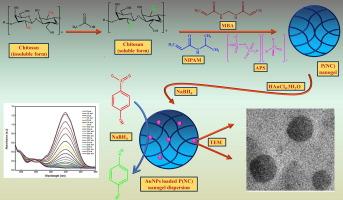Poly(N-isopropylacrylamide)-chitosan nanogels for nanotechnological and catalytic applications
IF 5.8
2区 化学
Q1 POLYMER SCIENCE
引用次数: 0
Abstract
Polymer nanogels consisting of poly(N-isopropylacrylamide) and chitosan [P(NC)] were synthesized using a free radical precipitation polymerization technique in an aqueous environment. This process involved the polymerization of N-isopropylacrylamide (NIPAAM) with chitosan (CS) and a cross-linker. These P(NC) nanogels were utilized as nano-reactors for the synthesis of gold nanoparticles (AuNPs), which were formed within the polymeric network through an in-situ reduction process using tetrachloroauric acid [H(AuCl4)] as precursor salt and sodium borohydride (NaBH4) as the reductant. Various analytical methods, including Transmission electron microscopy (TEM), Thermogravimetric analysis (TGA), Ultraviolet–visible spectroscopy (UV–Vis), and Fourier transform infrared spectroscopy (FTIR), were employed to confirm the formation of P(NC) nanogels and the incorporation and durability of AuNPs within the P(NC) nanogels. The AuNPs loaded P(NC) nanogels were utilized as catalysts for the reduction of 4-nitrophenol (4-NiP) into 4-aminophenol (4-AmP) in the presence of NaBH4. This system was also used to degrade a number of dyes including methylene blue (MB), methylene orange (MO), rhodamine B (RhB), brilliant blue (BB) and eosin Y ((EY) by using NaBH4 as a reducing agent. The Au-P(NC) catalyst exhibited remarkable efficiency, facilitating the fast reduction of 4-NiP and degradation of dyes within a very short interval of time. This system stands out for its economic usage, as even a small quantity of it can efficiently reduce toxic pollutants like 4-NiP and dyes. The results of the reactions highlighted exceptional yield, emphasizing the effectiveness and recyclability of the Au-P(NC) hybrid nanogels as highly capable catalysts.

用于纳米技术和催化应用的聚(N-异丙基丙烯酰胺)-壳聚糖纳米凝胶
采用自由基沉淀聚合技术,在水环境中合成了由聚(N-异丙基丙烯酰胺)和壳聚糖[P(NC)]组成的聚合物纳米凝胶。该工艺涉及 N-异丙基丙烯酰胺(NIPAAM)与壳聚糖(CS)和交联剂的聚合。这些 P(NC)纳米凝胶被用作合成金纳米粒子(AuNPs)的纳米反应器,金纳米粒子是通过以四氯金酸[H(AuCl4)]为前驱盐、硼氢化钠(NaBH4)为还原剂的原位还原过程在聚合物网络中形成的。实验采用了多种分析方法,包括透射电子显微镜(TEM)、热重分析(TGA)、紫外-可见光谱(UV-Vis)和傅立叶变换红外光谱(FTIR),以确认 P(NC)纳米凝胶的形成以及 AuNPs 在 P(NC)纳米凝胶中的结合和耐久性。负载 AuNPs 的 P(NC)纳米凝胶被用作催化剂,在 NaBH4 的存在下将 4-硝基苯酚(4-NiP)还原成 4-氨基苯酚(4-AmP)。该系统还被用于以 NaBH4 为还原剂降解多种染料,包括亚甲基蓝(MB)、亚甲基橙(MO)、罗丹明 B(RhB)、艳蓝(BB)和曙红 Y(EY)。Au-P(NC) 催化剂的效率非常高,能在很短的时间内快速还原 4-NiP 并降解染料。该系统的突出特点是使用经济,因为即使是少量的催化剂也能有效地还原 4-NiP 和染料等有毒污染物。反应结果表明,金-P(NC)杂化纳米凝胶具有极高的产率,是一种高效的催化剂,并可回收再利用。
本文章由计算机程序翻译,如有差异,请以英文原文为准。
求助全文
约1分钟内获得全文
求助全文
来源期刊

European Polymer Journal
化学-高分子科学
CiteScore
9.90
自引率
10.00%
发文量
691
审稿时长
23 days
期刊介绍:
European Polymer Journal is dedicated to publishing work on fundamental and applied polymer chemistry and macromolecular materials. The journal covers all aspects of polymer synthesis, including polymerization mechanisms and chemical functional transformations, with a focus on novel polymers and the relationships between molecular structure and polymer properties. In addition, we welcome submissions on bio-based or renewable polymers, stimuli-responsive systems and polymer bio-hybrids. European Polymer Journal also publishes research on the biomedical application of polymers, including drug delivery and regenerative medicine. The main scope is covered but not limited to the following core research areas:
Polymer synthesis and functionalization
• Novel synthetic routes for polymerization, functional modification, controlled/living polymerization and precision polymers.
Stimuli-responsive polymers
• Including shape memory and self-healing polymers.
Supramolecular polymers and self-assembly
• Molecular recognition and higher order polymer structures.
Renewable and sustainable polymers
• Bio-based, biodegradable and anti-microbial polymers and polymeric bio-nanocomposites.
Polymers at interfaces and surfaces
• Chemistry and engineering of surfaces with biological relevance, including patterning, antifouling polymers and polymers for membrane applications.
Biomedical applications and nanomedicine
• Polymers for regenerative medicine, drug delivery molecular release and gene therapy
The scope of European Polymer Journal no longer includes Polymer Physics.
 求助内容:
求助内容: 应助结果提醒方式:
应助结果提醒方式:


